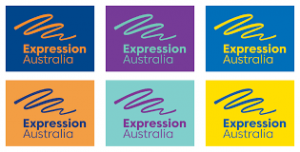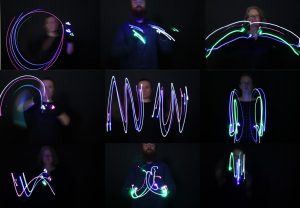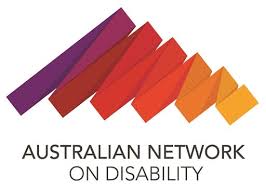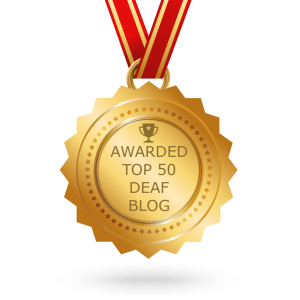In the second of a two-part series on Vicdeaf’s change of name, MICHAEL UNIACKE looks at the words ‘expression’, ‘Australia’ and the new logo
“IF I TOLD YOU THERE was an organisation called “Expression Australia”, what would you think would be its business?”
I asked a dozen people this question. All were hearing people, and none of them had any connection with deafness. This was not a survey but an informal vox pop (voice of the people). Their responses? (a) they had to stop and think about it; (b) nearly all wondered if the organisation had something to do with the arts; and (c) someone wondered about literature. This person knew me as a writer, so she had made that connection.
When I told them it was the new name for the major deafness organisation formerly known as Vicdeaf, their response was, aha! It took a while, but it did make sense to them. They had made a connection with communication. One friend, who is a graphic designer, thought it was pretty clever.
What was apparent to me was the reflection of these people on the meaning of the word ‘expression’. The synonyms (different words with a similar meaning) for expression reveal words that make up the way that humans communicate. Dictionary.com gives 14 definitions of ‘expression’. Definitions three to seven capture words, voice, intonation, looks. Number five in particular is worth quoting:
“indication of feeling, spirit, character, etc., as on the face, in the voice, or in artistic execution”
Deaf people do all that. Even a connection with the arts is a pleasing one, given a link with sign language as an art form. Sign language is a theatrical form of communication. Expression and its shades of meanings cover much of way sign language works, in particular because facial expression remains a critical and theatrical part of the language. But why this word ‘expression’ in particular?

“We followed an ‘Auslan-first’, which is an Australian first, and perhaps a world-first process,” says Expression Australia’s CEO, Chris Mathieson. “We thought about themes, ideas and context before we considered English words. When looking at these concepts we realised that the Deaf Community has a strong belief in that people should be able to choose the way in which they communicate. This idea of ‘diversity of expression’ is valued by the organisation, delivered through our different services,” she says.
In other words, Vicdeaf started with Auslan, looked into its context and wider meanings, and came up with ‘expression’ to imply that deaf people communicate in a variety of ways. That makes a certain sense, although it misses the protective feeling that many deaf people have for the word ‘deaf’.
“ ‘Expression’ is very broad,” continues Mathieson. “It includes sign language, facial expressions, body movements and use of space. ‘Expression’ also acknowledges that everyone is different in how they live their life and how they see the world. ‘Expression’ also reflects how rich and dynamic Auslan is,” she says.
IN 1880, AN EXCITED correspondent for the London Times reported that “deafness is abolished”. This reporter wrote about the now-infamous Congress of Milan in Italy, where a conference of European educators of the deaf voted to abolish sign language from the teaching of deaf children, and instead, to use lipreading and speech training for instruction.
In an 1880 edition of the American Annals of the Deaf, the Gallaudet brothers and others who attended had a bit to say about the Italian clerics who dominated the congress. They noted the multiple ways in which Italians used gestures to supplement Italian as a spoken language. They described one of the Italian clerics, the Reverend Giulio Tarra, one of the congress’s fiercest critics of sign language, as “a born sign-maker”. In other words, he and many of his brother clerics used signs to denounce sign language.
Different sides
Among his many reasons for denouncing sign language, the Reverend Tarra believed signs aroused “sinful passions” in the signer. No one seems to have pointed out to him that speech can do just the same. Both speech and signing are different sides of the coin of expression.
What is revealing is that the organisations in deafness which reject sign language, especially those with “speech and hearing” in their titles or in their mission statements, immediately restrict the range of human expression. They are effectively saying: you may express yourself in this way, but we do not allow you to express yourself in that way. That’s another way of denying the humanity of people with any form of hearing impairment. Generations of deaf children, schooled in oralism and made to sit on their hands to prevent them from signing, will say and sign “amen” to that. It adds potency for the role of the word ‘expression’ when it comes to communication.
MY FIRST RESPONSE to the change of name was to note the word ‘Australia’ in the new title. It’s a major jump from a state organisation to a national body. Will Expression Australia therefore have clients from all around the country?
“While we may not offer all of our services nationally,” says Chris Mathieson, “we currently already provide services beyond Victoria alone and into Tasmania, for example. We wanted to have a name that was united, rather than divided by state names,” she says.
“We want to be able to partner and advocate on behalf of the people we represent without geographic limits, so that the benefit of our work is had wherever they are needed in Australia. However, our core focus is still Victoria and Tasmania,” Mathieson says.
Across the country, state names are disappearing. In Sydney, it’s now ‘The Deaf Society’, in Brisbane, it’s ‘Deaf Services’, and Adelaide’s organisation copes with the odious name of ‘Deaf Can Do’. Once again, this reflects the impact of the NDIS on the work of these organisations.

THE MOST HILARIOUS description of Expression Australia’s logo that I heard was that it resembled an angry tapeworm. EA should not worry. That’s the fine old Australian tradition of taking the piss. More important is the story of how the logo was teased out through signing in lighted gloves captured on a camera on time delay. I’ve seen signs captured on film this way, particularly in linguistic research, but not for the purposes of developing a logo. While I don’t think the logo portrays any one particular sign, it does remind me of the sign for ‘diversity’.
In spite of the logo’s general resemblance to that of the Australian Network on Disability, there is no risk that AND’s logo will resemble a sign – its ribbon is rectangular and lacks the rounded flow of EA’s logo.

The critical work for Expression Australia is beginning. It has time on its side for its name and logo to become better known and established in the public eye as capturing the diverse ways in which humans communicate with each other.

Leave a Reply